|
In order to thoroughly understand and take full advantage of the CNBA Part IV review, we highly recommend that you study the sections provided in this software in the following order:
| 1. Introduction |
| 2. Case History |
| 3. Physical Examination |
| 4. Orthopedic |
| 5. Neurology |
| 6. Technique |
| 7. Clinical Laboratory |
OVERVIEW OF THE NBCE PART IV EXAMINATION |
The part IV examination consists of the following three sections: |
| I. Diagnostic Imaging (DIM) aka X-ray interpretation
(please check w/ NBCE to see if you are required to take DIM w/ part IV) |
| II. Case Management. |
| III. Chiropractic Technique. |
Below you will find a brief description for each section. A more detailed description for these sections will follow.
I. Diagnostic Imaging (DIM) aka X-ray interpretation |
-
Consists of 20 stations. You are given 2 minutes per station.
- During the DIM portion, you will be viewing diagnostic images on a monitor and answering 2 questions related to the image(s). Additional brief clinical data will also be provided for each station.
- On some stations (one or two of them), NBCE may ask you to identify various types of special imaging such as: MRI, CT, Bone Scan, Ultrasound, etc. They may also ask you to identify the findings or structures on these images such as Disc Herniations/Bulges, Spinal Cord Compression, Hematoma, Tumor, Fractures. They may also point an arrow on an structure and ask you to identify it (i.e. Abdominal Aorta, Liver, Urinary bladder etc).
|
|
1. Consists of 20 stations. You will be given 5 minutes in each station.
2. A pre-station is where the simulated patient will be. You will be given 5 minutes for all of the pre-stations.
3. A post-station immediately follows the pre-station. At the post-stations, you will be required to answer questions regarding the case presented in the pre-station. You will also be given 5 minutes in all of the post-stations.
4. The 20 case management stations consist of the following sections: Case History, Ortho/Neuro, and Physical Examination. For each of the sections listed below, you will be required to do the following:
|
a. Case History -- Perform a brief focused case history.
b. Orthopedic/Neurological -- Perform a brief focused Orthopedic/Neurological examination.
c. Physical Examination -- Perform a brief focused physical examination.
|
5. At each station you will be required to perform/choose one or more of the following:
|
a. Choose the most likely diagnosis and/or clinical impression.
b. Choose the most appropriate case management procedure.
c. Choose the neurological signs most likely to be present.
|
6. You will have the opportunity to perform the examinations on a patient who has been trained to simulate a clinical condition. There will be an observing doctor in the same room grading your performance.
|
7. Some stations will require you to interact with the observing doctor and the notation (verbal component) will be written next to the listed examination(s). When you see verbal component written next to an examination, your job will be to explain and perform the procedure/examination on the patient, and report your findings to the observing doctor.
|
| 8. In the post-station answers, there will be two sections (A and B), and you will be required to select three of the "best" answers from each section related to the case presented in the pre-station. Additional clinical data regarding the patient will be provided in all of the post-stations.
|
|
Back to Top of Page
|
1. Consists of 5 stations (two set-ups per station). You will have 5 minutes to fully complete the set-ups in each station.
2. At each technique station, you will be given listings/subluxations from the following regions of the body:
a. Two cervical
b. Two thoracic
c. Two lumbar
d. Two pelvic/sacrum
e. Two extremity
- The instructions will state the type of set-up you would need to perform for each of the listings/subluxations. Patient position, doctor hand contact, and segmental contact will always be provided.
3. You will be required to only "set-up" for each of these listings/subluxations. This means you should never attempt to thrust or adjust the patient.
4. At times, you may also be required to show static and or motion palpation techniques and to describe joint-related anatomical landmarks. For example: If a listing requires you to set-up on the C7 spinous process, the observing doctor may ask you to explain how you found the C7 spinous process.
5. You will be evaluated by an observing doctor (licensed chiropractor).
|
LET'S TAKE A CLOSER LOOK
Day 1 of the Part IV Examination
(First part of the Part IV Examination)
On the first day of the Part IV Examination, you will be tested on Diagnostic Imaging, which consists of 20 stations. The X-ray films will be displayed on a computer screen and a booklet with the Questions and Options will be provided.
Again, you will have 2 minutes to select 2 answers per station (1 answer from the 4 choices provided from Section A and 1 answer from the 4 Choices provided from Section B as shown in the sample questions below).
NBCE will provide you with a brief history of the patient (for example: 25 year old female complaining of left wrist pain after a fall or a 55 year old male complaining of chronic lower back pain).
Below is an example of how the questions may appear in the booklet:
Station 1: Section A
Choose 1 finding evident on the radiograph.
1. Sail Sign
2. Bamboo Spine
3. Snow ball appearance
4. Fat pad sign
|
Station 1: Section B
Choose 1 management for this patient.
1. Chiropractic Adjustments
2. An MRI study
3. Place patient on a proper exercise, diet and stretching program
4. Bone Scan
|
After the Diagnostic Imaging (DIM) examination:
After you complete and are excused from the DIM examination, you will be dismissed and given a sheet of paper which will indicate the day (Saturday or Sunday) and the time you will need to return for the second part of the Part IV examination (which consists of all the other sections: Case Management and Technique). It should be noted that some testing locations will examine students on Friday and Saturday and others will have Sunday included as well. Bring your lunch on the 2nd or 3rd day because you will not be allowed to leave the building or the testing site while the examination is being administered. Also, while you are in the process of taking the examination, you will not be allowed to use the restrooms or leave the testing site.
Back to Top of Page
Day 2 or Day 3 of the Part IV Examination
(Second part of the Part IV examination)
The Second part of the examination consists of the following sections and stations:
There are 25 stations overall which consist of the following:
Stations |
# of Pre-stations |
# of Post-Stations |
Technique |
5 |
0 |
Case History |
3 |
3 |
Ortho/Neuro |
6 |
6 |
Physical examination |
1 |
1 |
TOTAL |
15 |
10 |
Back to Top of Page
Breakdown of the stations and the routine:
Prior to entering the pre-station (this is where the simulated patient will be), you will have 1 minute in the hallway (here you will find a brief history of the patient and a list of the examinations that you would need to perform as you enter the room). After the 1 minute in the hallway, there will be an announcement or a signal, which will permit you to enter the room (pre-station). Once you enter the room (pre-station), quickly give your labels to the observing doctor inside the room, introduce yourself to the patient and begin the examination. Once the examination begins (5 minutes), there will be an announcement again at the last 30 seconds of the examination to help you wrap things up. As you finish the pre-station room and are getting ready to exit the room, don't forget to pick up your answer sheet from the observing doctor. After you leave the examination room (pre-station), you will again enter the hallway, where you will remain for another 30 seconds. At this point you will organize your thoughts and findings and again there will be a signal or an announcement instructing you to enter the post-station. In the post station room, you will have another 5 minutes to answer questions (multiple choice) regarding the case presented in the pre-station. Here you will be required to choose 3 answers from section A and 3 answers from section B. (Note: In the Diagnostic Imaging section of Day 1, you will be required to choose only 2 answers from section A and 2 answers from section B. Please refer to the introduction video, which shows and describes the entire procedure and the routine of the examination. Below you will find additional information regarding each station.

Stations |
Comments |
Technique |
5 technique stations which consist of 2 "set-ups" per station.
- You have 5 minutes to complete both "set-ups" in each station.
|
Case History |
3 case history pre-stations and 3 case history post stations.
- You have 5 minutes in each pre-station and 5 minutes in each post station.
|
Orthopedic/Neurology
|
6 ortho/neuro pre-stations and 6 ortho/neuro post-stations.
- You have 5 minutes in each pre-station and 5 minutes in the each post station.
|
Physical Examination |
1 physical examination pre-station and 1 physical examination post-station.
- You have 5 minutes in each pre-station and 5 minutes in each post station.
|
Back to Top of Page
Process of the Part IV Examination - Step by Step
Step 1: The hallway (prior to entering the pre-station)
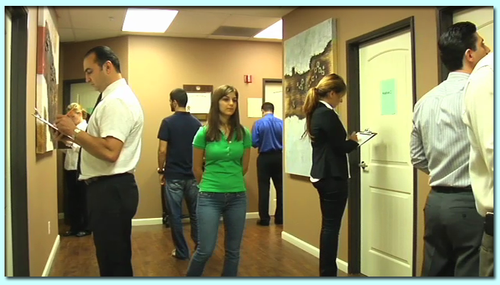
In the hallway (this is where the examination begins), you will be given one minute to read through the case, the tests you will need to perform, and other instructions displayed by the door.
Do not bother writing down any instructions or examinations given to you in the hallway for the same instructions will be displayed in the room (pre-station) as you enter. The instructions will either be placed on a clipboard or on the wall as you enter the room. There will be staff to assist you from one room to the other, so don't panic. Below you will also find a sample of how the instructions may be presented (click here)
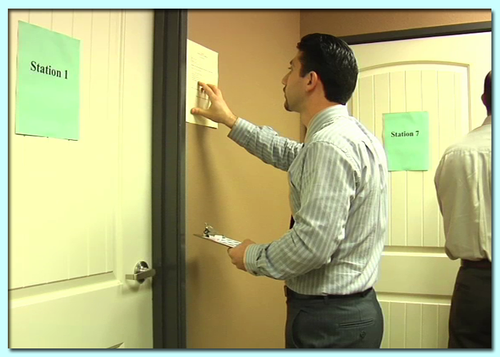
Sample Instructions |
STATION 1
INSTRUCTIONS TO CANDIDATE
PATIENT DATA
Name: James Collins
Age: 25
Occupation: Carpenter
Presents with Lower Back Pain
PERFORM A FOCUSED ORTHOPEDIC/NEUROLOGICAL EXAMINATION
Perform the following orthopedic and neurological procedures:
1. L4, S1 Deep Tendon Reflexes
2. Straight Leg Raise Test
3. Bechterew's Test
4. Adam's Test ( Verbal Component )
5. L4, L5, S1 Dermatome Testing
NOTE: At the next station (2) you will be required to answer questions related to this patient's condition
Please have your two identification labels ready |
In the hallway (before entering the pre-station), quickly read what is presented to you and work up a strategy or develop an idea of how you're going to approach the patient or the case (here you should come up with a few possible differentials simply by observing the type of examinations they have displayed for you to perform).
Then, prior to entering the pre-station room from the hallway, quickly take two labels off the label sheet and place them on your clipboard or on your hand as shown in the image below (This will save you time as you enter the room and will allow you to quickly give your labels to the observing doctor and begin the examination). There will be an announcement that will instruct you to enter the room. Remember, everyone is on the same time frame and you will not be allowed to rush to the restroom during or between stations.
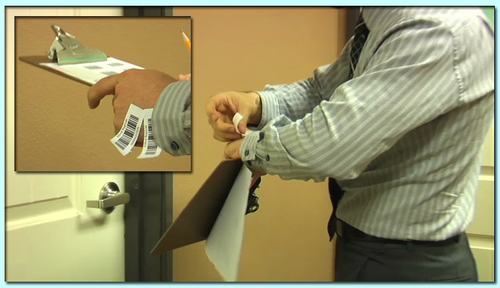
Back to Top of Page
Step 2: The pre-station (as you enter from the hallway)
As you enter the pre-station, the patient will be in the room along with an observing doctor of chiropractic. The observing doctor will not speak to you during the examination and he or she will not respond if you ask any questions. They are simply there to observe and grade your performance.
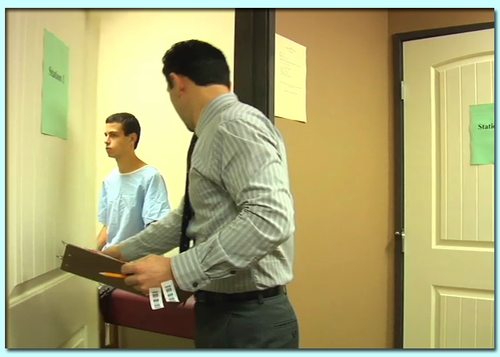
As you enter, greet the doctor and give him or her both of your labels immediately. The observing doctor will place one label on your grade sheet and the other label will be placed on the answer sheet, which will be given to you after you complete the pre-station. You will use this answer sheet for the post-station questions.
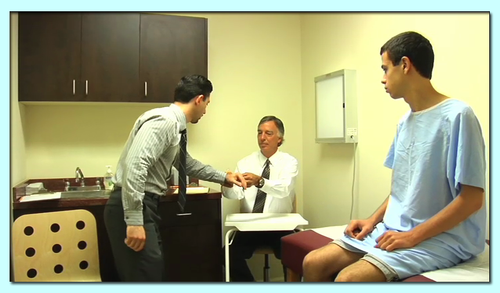
Begin by always introducing yourself to the patient. Then ask the patient to explain the reason for their visit by asking "What brings you here today?". After you have heard the patient's complaint and the reason for their visit, explain to the patient what you are going to do. You will be allowed to interact with the patients during the physical and ortho/neuro examinations and ask them questions before, during, and after you perform the tests/examinations. You will have 5 minutes in each pre-station, and there will be an announcement when there is 30 seconds left to help you wrap things up.
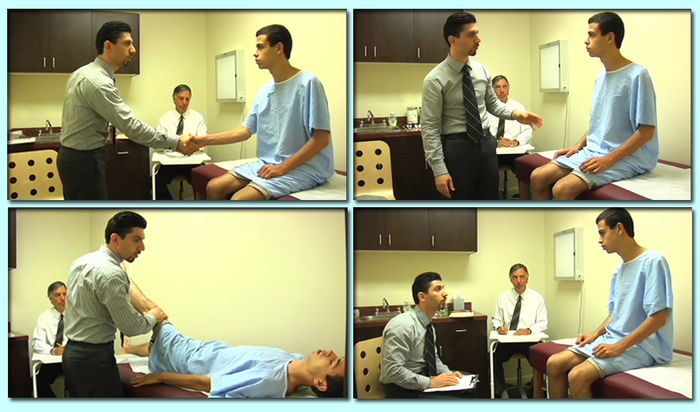
When the 30 seconds is over, you will be instructed to leave the pre-station and at this point the observing doctor will hand you the scantron/answer sheet (with your label on it) to take with you as shown below.
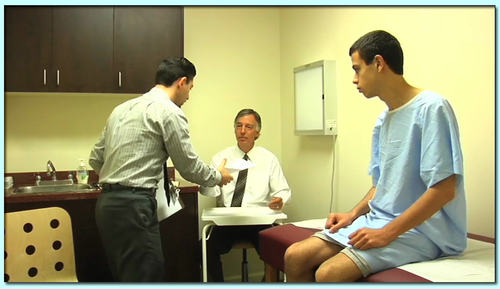
Back to Top of Page
Step 3: The Hallway (as you leave the pre-station and prior to entering the post-station)
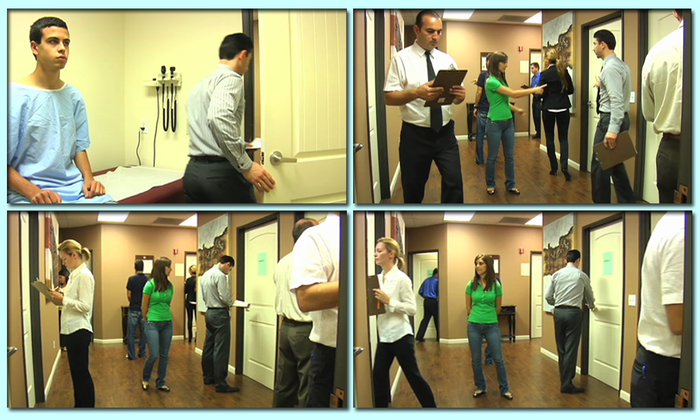
As you leave the pre-station and prior to entering the post-station, you will be given 30 seconds in the hallway to organize your thoughts and findings from the pre-station. There will be staff to assist you and direct you from one room to the other. Again, you will then be instructed to enter the post-station with an announcement (Note: For the post-stations, you do not need to prepare the labels in the hallways; only prepare the two labels prior to entering the pre-stations and the technique stations).
Back to Top of Page
Step 4: The Post-station (as you enter from the hallway)

Here you will be required to answer questions (multiple choice) regarding the case presented in the pre-station. You will be provided with additional information regarding the patient such as additional history and clinical laboratory tests. A radiograph for each patient will also be displayed at each post-station as shown below to help you with your diagnosis. You will have 5 minutes in each of the post-stations, and there will again be an announcement when there is 30 seconds left to help you wrap things up. Once the 30 seconds is over, and you have been instructed to move to the next station, you will leave your answer sheet on the table as shown below and NBCE staff will collect your answer sheet. The cycle will begin again (steps 1-4) as you leave the post station.
Step 1: Hallway (1 min)
Step 2: Pre-station (5 min)
Step 3: Hallway (30 sec)
Step 4: Post-station (5 min)


Back to Top of Page
Important Considerations
The goal of the Part IV examination is to not only perform the examinations/tests correctly, but to also obtain valuable information from the patient by asking specific questions, which will be provided for you in this review. If you enter the pre-station and solely perform the examinations presented, and in the post station you begin to have difficulty answering the questions properly, this means you did not do a thorough job as far as either properly examining the patient and/or asking questions relevant to the patient's condition.
Below you will find and example that will help you understand the importance of asking detailed questions and taking a thorough history while you are examining the patient. Do not rely on objective findings alone to come up a diagnosis.
For example: Sample Case
You enter a room with a 60 year old female complaining of deep thoracic spine pain. She felt the pain immediately after bending forward to pick up a book from the ground. Your examination revealed the following findings:
1. Vibratory Test -- localized thoracic spine pain.
2. Kemp's Test -- localized thoracic spine pain.
3. Soto Hall Test -- localized thoracic spine pain.
4. Sternal Compression Test -- Negative
5. Thoracolumbar ROM -- limited range of motion with all movements due to pain.
(Flexion movement produced an increase of pain)
|
Overview:
The patient had limited range of motion with all movements (flexion of the thoracic spine produced an increase of pain). At this point, based on the mechanism of injury and the Orthopedic/Neurological examination findings alone, you may be thinking a compression fracture possibly due to her age, or perhaps a sprain/strain (or even both).
In this situation and all situations, you must ask specific questions to rule out one from the other. Let us assume you do NOT ask any further questions because you feel certain that she has a compression fracture considering her age and based on the ortho/neuro examinations that you have performed. You enter the post station, and notice a compression fracture on X-ray. You get excited and your heart races because you feel you properly diagnosed the patient. Guess what? Here's where you're wrong and you begin to panic. It's true that she has a compression fracture; however we feel that NBCE does not care about the obvious diagnosis in general. On the answer sheet, you notice the following options (Notice how "compression fracture" is not listed as one of the answers or options):
A) Choose one etiology and two findings.
1. Tuberculosis
2. Osteoporosis
3. Metastatic Lung Cancer
4. Stable fracture
5. Infection
6. Multiple Myeloma
7. Metastatic Breast Cancer
8. Urinary incontinence
9. Kyphosis
10. Progressive weakness of the legs |
B) Choose three management options for this patient.
1. Adjust the patient using low Amplitude high Velocity technique
2. MRI
3. Referral to an Orthopedist
4. Back Strengthening Exercises
5. CT-Scan
6. NCV testing
7. Additional Blood Tests
8. Doppler Ultrasound
9. Bone Scan
10. Flexion distraction technique |
Back to Top of Page
Interpretation:
Answering the questions correctly in section A and B above will require that you thoroughly examine the patient in the pre-station and obtain valuable information by asking additional and specific questions (most of these questions will be provided to you in this review). The examinations and objective findings alone usually will NOT be enough to answer all of the questions in the post-stations. Additional and appropriate questions must be asked along with the examinations (orthos/neuros) in order to properly diagnose and answer the post-station questions correctly.
Note: If you did NOT ask the patient in the sample case above about progressive weakness of the legs or whether she had difficulty with urination (which happen to be choices presented above), then you will most likely have difficulty choosing the correct answers. If you were not observant during the examination regarding whether the patient was stooping (kyphotic) or not, then it would be hard for you to determine if "Kyphosis" would be appropriate for an answer. For that matter, if you are not observant and do not take a thorough history along with the ortho/neuro examinations, you will have difficulty answering the questions in the post-stations. Therefore, if you suspect a compression fracture during an examination, ask as many detailed questions as possible to determine the underlying etiology of the compression fracture (this applies to all conditions).
Furthermore, family history is very important and should not be forgotten or ignored. If you were to ask the patient about family history of related conditions or other illnesses, she could have told you that her mother died of breast cancer, which would be a clue that she (the patient) may possibly have a compression fracture associated with metastatic breast cancer. Also, if you were to ak if she was ever diagnosed with any condition or disease prior to seeing you today, she could have possibly stated that she had Tuberculosis or Osteoporosis. National Boards Part IV Examination is very standardized and NBCE wants the student to be very involved in determining the diagnosis. In addition, although this may not always be true from a clinical point of view, if the patient tells you during the examination that "My mother died of breast cancer", then it is worth noting that this information is valuable and therefore should be acknowledged (this is a clue that the patient herself may have Cancer as well).
It should be mentioned that all conditions and pathologies presented by the patients will have a true cause, distinct symptoms which will be simulated by the patient, and other related problems which these conditions can also present with(For example: Osteoporosis can also cause a compression fracture or any type of fracture, DISH can cause stenosis and difficulty in swallowing, and a lumbar disc herniation may cause loss of sensation, radiation, and eventual muscle weakness due to nerve compression. You must then take under consideration all aspects of the pathology or a condition in order to come up with a true diagnosis (remember a diagnosis may have a few components as discussed above). Lastly, if you are confident and certain that a patient has a certain pathology or condition during the course of your examination DO NOT stop there. Your next most important objective will be to determine the most common and possible conditions and symptoms associated with the disease or pathology (NBCE will definitely ask you to identify these in the post-stations as discussed above).
CLUES, CLUES AND MORE CLUES:
It is important to look for clues as you enter the examination room. The patient may be wearing a brace, a hat, sunglasses, holding a cigarette pack; sitting or standing in an antalgic position to relieve the pain or hunching forward (which could suggest a compression fracture). These are clues that NBCE wants you to notice, and these clues should assist you to further question the patient and obtain valuable information. Always acknowledge such findings and attempt to elaborate on these findings by asking additional questions. Refer to the example below:
Example: A 25 year old male presents with wrist pain of one year duration. You are asked to perform certain ortho/neuro exams on the patient. As you enter the pre-station, you introduce yourself and notice that the patient is wearing a hand brace. You immediately begin performing the examinations and ignore asking why the patient is wearing a brace. This could cause you to fail that particular station or section because you have failed to properly examine the patient, which requires that you take a proper history and perform the examinations correctly. Remember, when you see a clue you must address it to show the observing doctor that you have noticed it (observation). Then you should ask why he is wearing a brace and the patient will give you more clues or hints to help you with the diagnosis.
Lastly, prior to beginning the examination, you must also ask the reason for their visit and how the pain/injury came about (mechanism of injury). Knowing the mechanism of injury can help you rule out certain red-flags, help you narrow down your differentials and make you more aware of the type of condition you're dealing with. Then, after the reason for their visit and mechanism of injury has been determined (if there was any), instruct the patient to carefully take the brace off prior to beginning the examination. You are also being graded for patient interaction and consideration. Treat each case as if it were true; be very cautious and courteous with the patients and treat each patient as if he or she in fact has a true medical condition or problem.
Back to Top of Page
Verbal Component
What is a verbal component and what should be done?
In general, disregard the observing doctor grading you unless the examination asks for a "verbal component" (this means that you should perform and explain the examination on the patient and explain the outcome or findings of the examination to the observing doctor). You will see a verbal component written next to one of the examinations in the list. Also, with some of the examinations, for example: auscultation of the valves of the heart, you simply have to locate the valves and state or explain their locations (this is also considered a verbal component and is explained in the physical examination section of the review).
For example:
1. Soto Hall Test
2. Adam's Test ( verbal component )
3. Jackson Compression Test
4. C5, C6, C7 dermatome testing
5. Shoulder Depression Test |
Notice that the Adam's Test above has a verbal component written next to it. Here's what will be required of you. Verbal Component: You are responsible for performing the examination on the patient and explaining to the observing doctor what you're looking for (findings).
Therefore, you would ask the patient to bend forward and attempt to touch his or her toes. State to the observing doctor why the examination is performed (its clinical use). Then, you would explain to the doctor what you are looking for during the examination (findings).
You would state, "The Adam's test is used to differentiate a functional scoliosis from a structural scoliosis". "With the Adam's test, I first ask the patient to bend forward and attempt to touch his or her toes" (at this point, instruct the patient to bend forward). "Then, I observe to see if the spine straightens out or remains unchanged during this movement". "If I notice a patient with scoliosis bending down and the spine straightens out, then it's an indication that the scoliosis is functional. If the spine remains unchanged as the patient bends forward, then it is an indication that the patient has structural scoliosis". Certain students fail a certain section of the examination because they are not aware of what verbal component means and what is required of them.
It should be noted that certain sections will be weighted more toward your final score. Below, we have provided a rough estimate of how much each section may contribute toward your overal total score.
1. DIM -- X-ray interpretation and diagnosis (10-15%) - Day 1 of the Examination
2. Orthopedic/Neurological (35-40 %)
3. Case History (20-25%)
4. Technique (15-20%)
5. Physical Examination (5-10%)
|
STATIONS:
| A. DIAGNOSTIC IMAGING (DIM) ( 10-15% of your total score ) |
The x-ray section tends to be a difficult subject for students. NBCE usually tests students on the most common conditions generally seen in chiropractic offices. For this section, you must recognize the pathology or the condition, be able to correctly choose the appropriate management, and be able to recognize all the signs and aka's (NBCE likes to ask these) associated with the condition(s). |
| B. ORTHO/NEURO ( 35-40 % of your total score) |
You will be required to perform the orthopedic examination(s) correctly. You are also being graded on patient interaction and your ability to obtain valuable data and information before, during, and after the examinations. Therefore, you will be allowed to, and you must fully interact with the patient at all times. Orthopedic/Neurological tests commonly asked on the part IV examination will be presented in the Orthopedic and Neurology sections of the review respectively. Roll over images of the most common orthopedic tests asked on the Part IV examination will also be available for you to follow in the software. |
| C. CASE HISTORY ( 20-25% of your total score ) |
For this section, you will be required to take a detailed HISTORY of the patient. You will not be allowed to touch the patient or have the patient perform examinations. Spend most of your time practicing on how to take a detailed history for it constitutes a major part of your total grade. Your responsibility in this section is to take a thorough 5 minute history of the patient and based on the information you obtain from the patient, you will be required to answer a series of questions in the post-station. Refer to the Case History section presented in the software for a detailed overview of that section.
Note: Do not use medical terms when speaking with these patients. These patients will not understand medical terminologies. For example, do not ask the patient if Valsalva makes their pain worse or if flexion and extension increase their symptoms. It is more appropriate to ask the patient if coughing, sneezing or bearing down increases their pain; or if bending forward and bending backward increases their symptoms. |
| D. TECHNIQUE ( 15-20 % of your total score ) |
Your responsibility in the technique stations will be to "set-up" for the listings provided by NBCE. The Technique section provided in this software is the most thorough review available and consists of the most common listings and set-ups that will be asked during the part IV examination. This section also contains images that show you how to perform each "set-up" in detail. |
| E. PHYSICAL EXAMINATION ( 5-10% of your total score ) |
You will be required to correctly perform 5 physical examinations/tests selected by NBCE. In this station, along with all the other stations, you will NOT be allowed to or be required to bring your own examination tools. NBCE will provide you with all the necessary tools needed to perform the examinations. As you enter the room, there will be a few examination tools displayed for you to use. It would be your responsibility to determine and use the appropriate tool required for a certain examination. For example: NBCE may provide you with a 128 Hz tuning fork along with a 512Hz tuning fork and ask you to perform a vibratory test. In this situation, you would need to choose the appropriate tuning fork for the examination which would be the 128Hz for the vibratory test. Also, if they have a stethoscope displayed in the room and the instructions do not ask you to auscultate any part of the body, then you should NOT. Only perform what is asked of you, and use the right judgment in choosing the correct tool for the examination. You are also allowed to interact with the patient before, during, and after you perform the examinations in order to obtain more information. Interaction is the key in the physical examination section. For example: If the patient presents with chest pain, you are allowed to interact and ask questions (which are provided in the physical examination sections of the notes) to determine whether the patient has a condition related to the heart, lung, a broken rib(s), costochondritis, esophagitis, hiatal hernia (GERD) or any other condition that may cause chest pain. The physical examination section in the software contains detailed notes, sample cases, and important questions that should be addressed during the examination. |
Back to Top of Page
CONCLUSION:
A. It should be mentioned that the patients are simulated and are "acting" out specific conditions, which they DO NOT have in reality. Always treat the patient as if he or she truly possesses the condition or the problem. Be cautious, gentle, and show significant amount of consideration for the patients throughout each examination.
Important rules to consider:
1. Patients will usually be able to simulate pain or certain symptoms such as dermatome changes, reflex changes, or present with symptoms related to certain conditions such as: pressure behind the eye which could suggest a tumor, or chest pain which could suggest a heart or lung condition or Right Lower Quadrant pain and nausea which could suggest Appendicitis. Be advised, these patients will NOT have a palpable or an observable tumor or an enlarged heart, liver; or perhaps an abdominal aortic aneurysm during the examination, however, they can present with signs and symptoms associated with these conditions during an examination of that particular organ or area. It would be your objective to find out about these signs and symptoms by correctly questioning the patient (these questions are provided for you in the software). Understand that NBCE will most likely NOT bring in patients that in actuality have severe diseases or conditions such as a few of the ones mentioned above.
2. If a case of an Abdominal Aortic Aneurysm (AAA) has been presented in one station for example, then you will not be presented with another case of an AAA in the other stations. This important rule applies to all other conditions. So if you are confident that a patient's diagnosis in station 8 for example was AAA, then the patient in station 14 for example will not have the same condition or diagnosis.
B. If a patient brings something to your attention, always expand on it for he or she is trying to tell you something important (If you do NOT expand the patient will not). If you ask the patient a question in the pre-station and the patient's answer appears as one of the options on the post station answer sheet, consider choosing that answer because the patients are trained by NBCE to provide certain answer only if it applies to their case.
For example (Sample Scenario):
During a Case History section, a 45 year old male presents with neck pain after a slip and fall on the buttock. If you ask the patient if he has visited any other health care professionals prior to seeing you and the patient answers yes, then ask more questions to find out possibly what the other health care professionals found and diagnosed him with. Ask if they gave him a diagnosis and if they knew what was wrong with him. If the patient elaborates and states "yes I was told it was a whiplash", then expect to see whiplash as a choice in the post-station. Note: this statement is true only if you ask the question correctly. For example, if you ask a patient if he or she has history of Cancer and the patient states NO, then you must ask further questions to confirm that the patient may or may not have cancer by elaborating and asking the patient for possible signs and symptoms of Cancer such as: If they have experienced or have had any history of unintentional weight loss, coughing up blood, waking up at nights, nausea, vomiting, unexplained type of pain, family history of cancer, etc. (Again, all of these important questions are provided for you in the software). If the patient continues to answer NO to any of the questions related to Cancer, then you can most likely rule out Cancer from your differentials unless further clinical data or testing proves the existance of Cancer such as metastasis on X-ray, biopsy findings consistent with Cancer, tumor markers or abnormal Blood Tests that may suggest Cancer. Almost always, the patiens in the Part IV examination will present with signs and symptoms of the condition in question.
In addition, always ask to determine if any of the patient's family members have or have had similar problems or have been diagnosed with Cancer for example (the patient will not tell you unless you ask). In the example provided above, if the patient answers "yes my mother died of breast cancer", then assume that the patient is trying to tell you something important (she will not expand unless you do). In this case, Cancer would be a possible diagnosis even though the patient might not possess the obvious signs and symptoms of Cancer at the time of the examination because not all Cancer patients do. It is also worth noting that if family history of cancer or any pathology is ruled out, it does not automatically prove that the patient himself/herself does not have cancer or a disease in question. In these tricky cases/situations, NBCE simply wants to see the extent of your history taking and will provide for you additional diagnostic information such as altered laboratory tests or x-ray findings in the post stations that are consistent and will confirm such a pathology (such as metastasis on x-ray). It should also be mentioned that it would be your responsibility to recognize and properly assess altered laboratory tests and pathologies on x-rays in the post stations.
In general, the simulated patients will present with signs and symptoms of certain diseases or conditions. Also, if you ask the patient questions and you notice that his or her answers are irrelevant to what you're asking and the patient seems to hesitate as he or she answers your questions, then you are most likely approaching the case incorrectly or asking unrelated questions. Change your approach and your direction of interest. The patient will only answer "yes" or will elaborate on a question if you ask a specific question related to his or her condition. Therefore, while in the hallway, consider the types of examinations NBCE has asked you to perform and come up with a few differential diagnoses as you enter the room but always make an objective to walk out of the examination room with one final diagnosis. This also applies to the case history sections. Although you will not be asked or required to perform examinations during the case history section(s), you must ask specific questions to rule out certain conditions. Understand that the test is very standardized and straight forward, and NBCE's intention is not to trick you or confuse you.
Lastly, make sure you are performing the examinations bilaterally (if necessary) and always start with the good side first. If a patient presents with right sided shoulder pain and you perform all orthos/neuros on the left side, the patient is trained to act as if nothing is wrong with that particular shoulder and he or she will not inform you that it is the opposite shoulder that should be addressed. You must be certain you are performing the examinations on the appropriate/affected side and bilaterally for comparison. If the patient's history (provided by NBCE) does not indicate the affected side, as you enter the room always ask the patient to point to the location of pain or complaint. Ask a few questions about the onset and mechanism of injury (these are described in detail in the software) and proceed with the examination. This will give you an idea of what type of a problem you are dealing with immediately and will guide you accordingly throughout the examination.
Back to Top of Page
Good Luck and Thank You for Choosing CNBA
|
|

